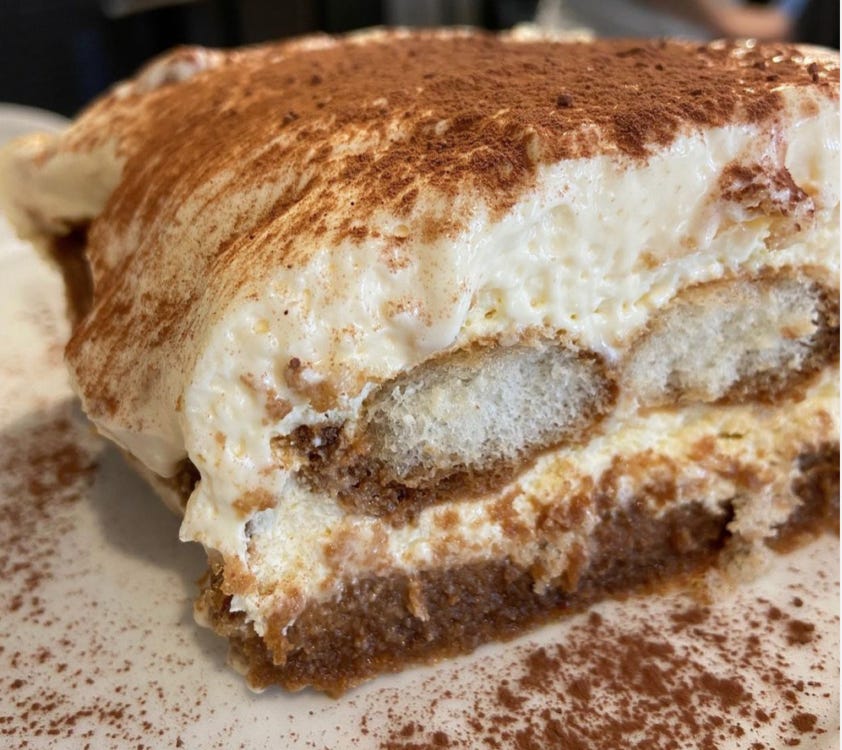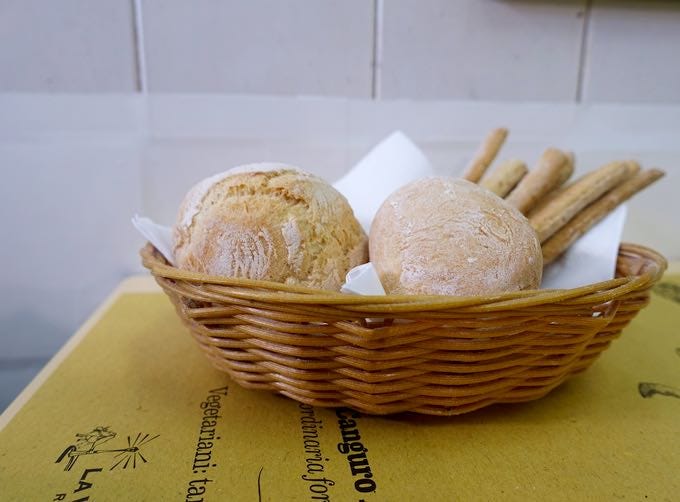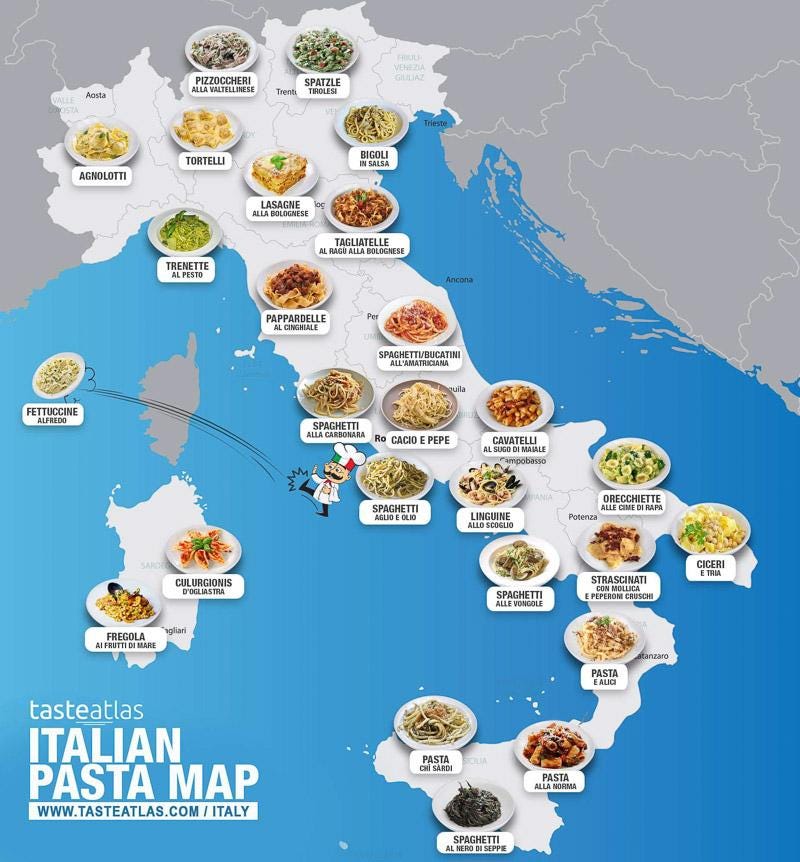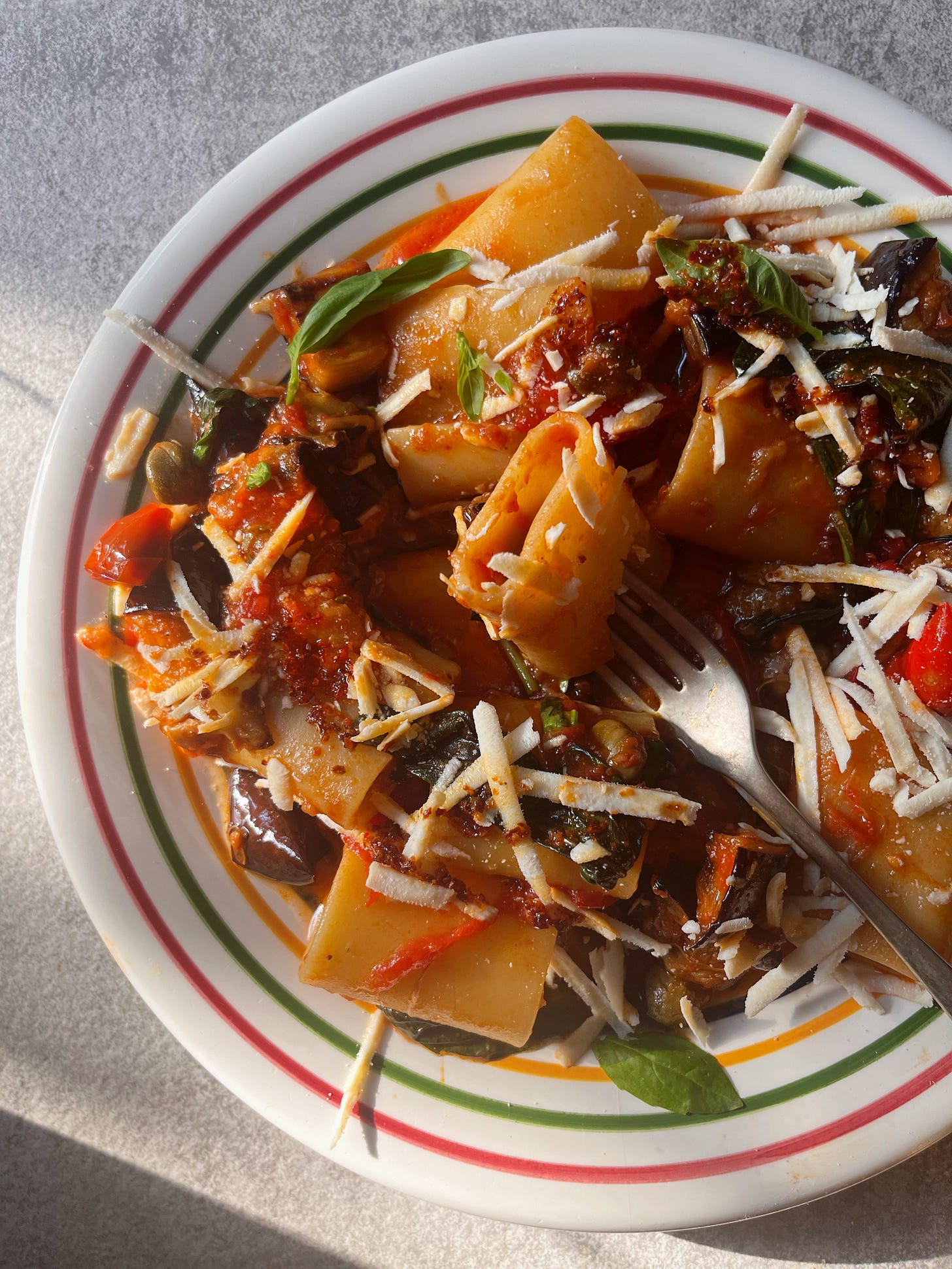What I’m currently consuming
The Dish: Tiramisu at Theo’s
Summer or winter, tiramisu always feels right. The undisputed King of the Tiramisu, Theo Lewis took the fiercely-contested title of Best Tiramisu In London 2021 arranged by Countertalk. Praised for its delicate dance between creaminess and lightness, booze and coffee, his tiramisu is truly outstanding. His pizzas are also as close to a visit to Naples as you can get, well worth a pilgrimage to Camberwell or Elephant and Castle.
The Article: Elizabeth Eminchilli’s 10 rules for eating bread in Italy
Guys, we’ve been doing it all wrong! Much like the etiquette around when you can drink cappuccino, it turns out that eating bread in Italy is also wrapped in invisible rules. This is an important read if, like me, you fear that disdainful frown on your waiter’s face. But to be fair, there’s no denying that they all make sense - it truly is a bit bananas that we Brits love to devour a whole bread basket before our meal even starts in a restaurants. What are we doing??
The Ingredient: Fontodi Extra-virgin Olive oil
Ok, this isn’t cheap, but all you need is the tiniest drop to take your food to fragrant, green, peppery heights - unreachable by anything you’d ever buy in a supermarket. This glorious stuff is grown in Tuscany in the Chianti Classico region by the Manetti family who tend to their olive trees with same love as the vines with which they make their world-famous wines. This oil, a ripe tomato, a pinch of salt. Heaven.
The Piece of Equipment: Hot Pottery Ceramics
My shelves are angrily groaning under the weight of spotty plates. Since discovering the traditional style of hand-painted ‘splatterware’ plates in Puglia, I haven’t wanted to eat off anything else since. Everything looks better with spots. I’m a big fan of the guys at Hot Pottery who have a thrilling range of different colours and styles. They’re super sturdy too, which is ideal if like me, you often do your washing up a bit tipsy. They’ve given me a 15% discount code levy15 to share with you all - if I’ve managed to sell the glories of eating off spots to you?
The Website: www.tasteatlas.com
I can’t quite get over how exciting this website it. Someone has done a huge amount of work attributing each area of Italy to its most famous dish, giving us the best local spots to eat the dish. And it’s not just a couple of suggestions, either. Tagliatelle al Ragu alla bolognese has 821 restaurant recommendations, Pasta Carbonara has 468. And they give you several versions of the recipe. And their suggested wine pairings. Oh and it’s all on a giant map of Italy. Hours of pre-holiday research fun.
Meet The Maker: Simon from Pastaio a Mano
I first encountered Simon’s pasta at my fave food shop, Jones of Brockley, where the owner Jemma, was singing the praises of this amazing pasta made in someone’s kitchen, BY HAND. This caught my attention, as you can imagine. As did Simon’s wonderful Instagram account. He’s always in the kitchen, banging out beautiful focaccia, plates of thrilling pasta and even chocolate-dipped crisps (deffo trying those). Needless to say, his pasta is epic. It takes just a few seconds to cook and brings its own flavour to your dish, imparted from the organic UK-grain flour he uses. Eighteen months after first dusting off his rolling pin in his kitchen, Simon’s pastas are stocked in delis and food shops across the country.
I asked him which shape he was most proud of and I really enjoyed his answer, so I’m giving you the whole conversation:
‘Without a doubt, it’s Mafalde. It’s the shape that’s most popular with shops and customers, but it’s also the shape that has been the most challenging to get into production.
Looking at the nested ribbons in the box, those frilly edges peeking out…they look so pretty you’d be hard pushed to even consider the trials and tribulations I went through with these.
When I decided that I was going to go for it with PAM, the pasta machine was already on its way from Italy. One of the bronze dies I had my heart set on was for Mafalde. I’d seen nests of it coiled up in pasta shops when we’d visited New York in 2019 and it was one of those shapes that once you see it, you can’t get it out of your head! What I didn’t factor in is…those nests were on sale loose and to be ordered by the pound. I quickly needed to find a way to box up the pasta in packaging that also fit the other shapes too.
Looking back now on the trials and tribulations of our Mafalde production, I laugh. So many variations of curled up nests, figures of eight, folded over ribbons...Some didn’t dry right. Some didn’t fit in the box. Some, well some were just total disasters. I then had my Eureka! moment. Flat-lay of ribbons, frilly edges tucked into a tight U-shape, nest them tighter and pack them into the drying tray more closely. Finally the nests looked great. They stood out as uniquely Pastaio a Mano, they dried perfectly - and most importantly of all, they all fit in the boxes!
It just goes to show, don’t judge a book by its cover. Next time you see a pretty box of pasta on the shelf believe me; there’s a story of late nights, head scratching, being covered in flour and turning the air blue with expletives behind every single box you see.’
Something to fill you up
Pasta alla Norma
I don’t know who Norma was, but she must be very proud. This dish, hailing from Sicily, was on every single menu during our recent visit to Catania. And rightfully so. The combination of melting aubergine (originally fried, but I prefer the healthier roasted version), simple tomato sauce and salted ricotta is a perfect example of the Italian higher understanding of simplicity (more on this in the Up on My Lunchbox section, below). I’ve tried to recreate the version we ate during my favourite meal in Catania, at the low-key-but-sensational wine bar, Razmataz.
The salted ricotta is an important element here, but it can be hard to find so you can substitute it for any salty-ish cheese such as feta, Lancashire, Pecorino or Parmesan. That said, foregoing it entirely makes this a brilliant vegan pasta as the aubergine brings real heft and substance to the party.
Try this summer banger! My how-to video is here.
Serves 4
100g olive oil
3 medium aubergines, cut into 2-3 cm chunks
4 garlic cloves, thinly sliced
1 heaped tbsp capers, soaked if salted
1 x 400g tin of plum or cherry tomatoes (fresh toms are nice here too)
2 big handfuls of basil leaves
400g large-shaped pasta (I like paccheri, rigatoni or penne)
A chunk of salted ricotta or other salty cheese, to serve
Preheat the oven to 240C/220C fan. Toss the aubergine in 3/4s of the oil (you’ll fry the garlic in the rest) so it’s evenly coated, then spread out evenly on one or two lined baking trays, not too closely packed in. Season lightly. Place in the oven for 30-40 minutes until golden all over, tender in the middle and a little darker on the edges.
(Do a thorough check that all pieces are done, life is too short for under-cooked aubergine.)
Meanwhile, warm the rest of the oil in a large pan over a medium-low heat. Add the sliced garlic and gently fry, stirring occasionally until it begins to turn sticky and colour on the edges. Once you can see it begin to turn golden, add the capers, wait a second, then add the tomatoes, breaking them up with your spoon as they go in. Season a little, then simmer for 20-25 minutes to reduce and sweeten while the aubergine is roasting.
Once the aubergine is cooked, bring a pan of salted water to the boil and pour in your pasta. Introduce the aubergine and a splash of water to the tomato sauce and simmer for a further 10 minutes so everything can mingle.
Once you get to al dente, drain the pasta, reserving some of the cooking water. Add the basil to the aubergine sauce, followed by the drained pasta and a big splash of the cooking water. Have a taste, adjust the seasoning if needed and stir gently for a few minutes until the pasta has absorbed some of the sauce and you’re happy with the consistency. Grate over the cheese, and serve. It’s still very delicious cold the next day - it makes a brilliant pasta salad.
Something to finish you off
I have little interest in eating anything at the moment unless it’s fruity and cold. So this Strawberry Sorbet from the River Cafe hits all the spots. They add a very special secret ingredient to their version: whole lemons (more on the magic of lemons in the Up on My Lunchbox section, below) that gives it a mouth-tickling tang. Utterly addictive.
The Seven Principles of Italian Cooking that Guide Me

1. Buy the best. This means always seasonal, always fresh. The better the quality, the less we need to do to them.
2. Simplicity. Following on from the statement above, many Italian dishes use just 4-6 ingredients meaning they rely on the magical interplay between the ingredients rather than complex preparation. Delicious food doesn’t have to involve lots of ingredients and fussy techniques. It’s all about enhancing the natural flavours in the food.
3. Soffrito. At the beginning of all slow-cooked dishes, soups and stews, there needs to be a strong base. A properly-cooked soffrito involving the mainstays of onion, celery and carrot at a ratio of 2:1:1 are essential to add depth of flavour to dishes.
4. Lemon. Their secret weapon. It lifts the flavour of dull food, cuts through richness and adds a zing like nothing else can. The zest also provides a subtle fragrance that elevates everything it meets.
5. Salt. Season and taste as you cook. Tiny adjustments as you go is the key to success. This is particularly the case with salt which needs to be added as you go along so it can properly permeate the dish, meaning less is used, too.
5b. Properly salting pasta water means we can add less to the sauce. 10-100-1000 is the ideal ratio (10g salt-100g pasta-1000ml water)
6. Pasta water. This is the magic ingredient in making a great pasta dish. It’s the glue that binds the pasta to the sauce. Adding some when the pasta is introduced to the sauce helps the sauce stick to the pasta. It thickens up loose sauce, loosens up thick sauce and creates a harmonious plate
7. Cooking from scratch. We all need to take shortcuts occasionally, but the sense of achievement you get from making something yourself is hard to beat. You know exactly what’s in it and get to make it just how you like it. I have a friend who only eats sugar if it’s in something homemade. Now that’s a diet I can get behind.

















I am going to print out your magnificent Lunchbox letters. Should be a book to treasure!